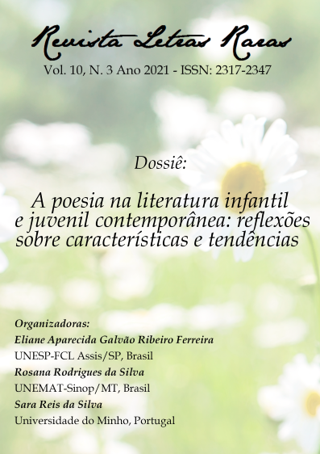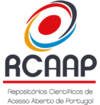Contemporary poetry in children’s Picture books: analysis of the work ‘Que lambança!’, by Ana Maria Machado
DOI:
https://doi.org/10.5281/zenodo.10065227Palavras-chave:
Contemporary Children's Poetry, Illustrated book, Reception Theor, Reader formationResumo
This paper aims to present a possible analysis of the book Que lambança! (2004(a)), written by Ana Maria Machado and illustrated by Denise Fraifeld based on the theoretical assumptions of Reception Aesthetics (JAUSS, 1994; ISER, 1996, 1999). This poetic work for children belongs to the collection "Gato escondido" (Hidden Cat), whose title, in the tradition of the genre, dialogues with popular culture, nursery rhymes and songs from popular folklore, especially with the tongue-twister of the same name: "Gato escondido com rabo de fora tá mais escondido/que rabo escondido com gato de fora" (A hidden cat with its tail in plain sight is more hidden than a hidden tail with a cat in plain sight). (CIRANDA DO BRAZIL, 2021). This dialog reveals the aesthetic project of the writer who understands the role of literature to be the constitution of a social memory, by rescuing a cultural heritage that, when appropriated, is constantly updated. In this way, the work presents itself as a game that challenges a discerning reader to discover what is "hidden" and "shown" between the lines and, especially, in the relationship that is established between its verbal and visual texts. Thus, the choice for the theoretical contribution of the Reception Aesthetics is justified, because the work of Machado (2004(a)), by the use of dialogue with a popular and infantile imagination, and the communicability with the implicit reader, which is established in the form of a game, manifesting itself both in the verbal and visual texts, shows that it aims to captivate the child to read.
Downloads
Referências
AGUIAR, Vera Teixeira de.; CECCANTINI, João Luís Cardoso Tápias (Orgs.) Poesia infantil e juvenil brasileira: uma ciranda sem fim. São Paulo: Cultura Acadêmica, 2012.
ANA MARIA MACHADO. Disponível em: . Acesso em: 10 fev. 2020.
BETTELHEIM, Bruno. A Psicanálise dos Contos de Fadas. Rio de Janeiro: Paz e Terra, 2007.
CAMARGO, Luís. Ilustração do livro infantil. Belo Horizonte: Editora Lê, 1998.
CIRANDA DO BRASIL. Disponível em: . Acesso em: 10 abril 2021.
CNEC ONLINE. “O pião no chão”. Disponível em: . Acesso em: 10 abril 2021.
CORSO, Diana Lichtenstein; CORSO, Mário. Fadas no divã: psicanálise nas histórias infantis. Porto Alegre: Artmed, 2006.
FARINA, Modesto; PEREZ, Clotilde; BASTOS, Dorinho. Psicodinâmica das cores em comunicação. São Paulo: Edgar Blucher, 2006.
FIORIN, José Luiz. Sendas e veredas da semiótica narrativa e discursiva. Revista D.E.L.T.A., vol.15, nº 1, 1999.
ISER, W. O ato da leitura: uma teoria do efeito estético. Trad. J. Kretschmer. São Paulo: Editora 34, v.1, 1996.
ISER, W. O ato da leitura: uma teoria do efeito estético. Tradução J. Kretschmer. São Paulo: Editora 34, v.2, 1999.
JAUSS, H. R. A história da literatura como provocação à teoria literária. Trad. S. Tellaroli. São Paulo: Ática, 1994.
JAUSS, Hans Robert et al. A literatura e o leitor: textos de Estética da Recepção. Seleção, coordenação e tradução de Luiz Costa Lima. 2. ed. re. e ampl. Rio de Janeiro: Paz e Terra, 2002.
LETRAS(a). “Fui no tororó”. Disponível em: . Acesso em: 10 abril 2021.
LETRAS(b). “Pirulito que bate-bate”. Disponível em: . Acesso: 10 abril 2021.
LETRAS(c). “Escravos de Jó”. Disponível em: . Acesso em: 10 abril 2021.
LETRAS(d). “O sítio do Pica-Pau Amarelo”. Disponível em: . Acesso em: 10 abril 2021.
LETRAS(e). “Se essa rua fosse minha”. Disponível em: . Acesso em: 10 abril 2021.
LETRAS(f). “A canoa virou”. Disponível em: . Acesso em: 10 abril 2021.
LETRAS(g). “Pezinho”. Disponível em: . Acesso em: 10 abril 2021.
LETRAS(h). “Peixe vivo”. Disponível em: . Acesso em: 10 abril 2021.
LETRAS(i). “Atirei o pau no gato”. Disponível em: . Acesso em: 10 abril 2021.
LETRAS (j). “Boi da cara preta”. Disponível em: . Acesso em: 10 abril 2021.
LETRAS(k). Rondo do capitão. Disponível em: . Acesso: 10 abril 2021.
LETRAS(l). “Sambalelê”. Disponível em: . Acesso: 10 abril 2021.
LETRAS(m). “Janelinha”. Disponível em: . Acesso: 10 abril 2021.
LETRAS(n). “Pintinho amarelinho”. Disponível em: . Acesso: 10 abril 2021.
LINDEN, Sophie Van der. Para ler o livro ilustrado. Trad. Dorothée de Bruchard. São Paulo: SESI-SP, 2018.
MACHADO, Ana Maria. Que lambança! São Paulo: Salamandra, 2004.
MARTHA, Alice Áurea Penteado. Pequena prosa sobre versos. In: AGUIAR, Vera Teixeira de; CECCANTINI, João Luís (orgs.). Poesia infantil e juvenil brasileira: uma ciranda sem fim. São Paulo, SP: Cultura Acadêmica, 2012, p.45-73.
NIKOLAVEJA, Maria, SCOTT, Carole. Livro ilustrado: palavras e imagens. São Paulo: Cosac Naify, 2011.
PEDAGOGIA AO PÉ DA LETRA. “Contando os botões”. Disponível em: . Acesso em: 16 out. 2020.
RAMOS, Graça. A imagem nos livros infantis: caminhos para ler o texto visual. Belo Horizonte: Autêntica Editora, 2011.
STALLONI, Yves. Os gêneros literários. São Paulo: Difel, 2001.
Downloads
Publicado
Como Citar
Edição
Seção
Licença
Copyright (c) 2023 Revista Letras Raras

Este trabalho está licenciado sob uma licença Creative Commons Attribution-NonCommercial 4.0 International License.







